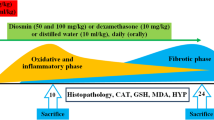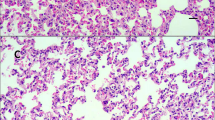Abstract
The abilities of captopril and niacin to protect against the lung toxicity of paraquat (PQ) were studied. The anti-oxidative action of captopril, an angiotensin-converting enzyme inhibitor, appears to be attributable to the sulphahydryl group (SH) in the compound, which gives captopril the ability to scavenge reactive oxygen species. Niacin replenishes the NAD and ATP depletion caused by reactive oxygen species. PQ causes lung damage in man and in several species of laboratory animals. The damage is initially manifested by hemorrhage and edema, and later by consolidation of the lung and fibrosis development. In this study, the lungs of male Wistar rats (250–300 g in weight) were perfused by Krebs-Ringer buffer alone (control), niacin (150 μM), captopril (10 μM) and PQ (600 μM) in perfusion fluid, and the biochemical changes that occurred in isolated rat lung were examined within 1 h and compared to PQ alone. The results show that captopril significantly decreases the lung weight/body weight ratio when used as a pretreatment and a post-treatment to captopril (p<0.0001). The results also show that captopril (10 μM) and niacin (150 μM) significantly decreases PQ-induced lung toxicity. Lactate dehydrogenase (LDH) activity significantly decreased in treatment groups as compared to the PQ group (p<0.0001). This study suggests that paraquat causes increased lipid peroxidation and LDH activity and decreased glutathione (GSH) and total protein in isolated perfused rat lung. These effects are reduced under these experimental conditions by captopril and niacin.
Similar content being viewed by others
References
Aldrich TK, Fisher AB, Candes E, Chance B (1983) Evidence for lipid peroxidation by paraquat in the perfused lung. Lab Invest 60:473–485
Aroma OI, Akanmu D, Cecchini R, Halliwell B (1991) Evaluation of the ability of the angiotensin-converting enzyme inhibitor captopril to scavenge reactive oxygen species. Chem Biol Interact 77:303–314
Barabas K, Serenyl P, Saelypes A (1990) Inhibition of lung damage caused by paraquat with lymphokines or cytokines. Exp Pathol 38:189–195
Bieri JG, Corash L, Hubbard VS (1983) Medical uses of vitamin E. N Engl J Med 308:1063–1071
Boobis AR, Fawthrop DJ, Davies DS (1989) Mechanisms of cell death. Trends Pharmacol Sci 10:275–280
Bus JS, Gibson JE (1984) Paraquat: model for oxidant initiated toxicity. Environ Health Perspect 55:37–46
Carre P, Leophone P (1993) Cytokines in pulmonary fibrosis. Rev Mal Respir 10:193–207
Chaturvedi P (1995) Isis-4 (Fourth International Study of Infarct Survival) Collaborative Group. A randomized factorial trial assessing early oral captopril, oral momonitrate and intravenous magnesium sulphate in 58050 patients with suspected acute myocardial infarction. Lancet 345:669–685
Chopra MH, Beswick M, Clapperton HJ, Dargie WE, Smith McMurray J (1992) Antioxidant effects of angiotensin-converting (ACE) inhibitors: free radical and antioxidant scavenging are sulfhydryl dependent, but lipid peroxidation is inhibited by both sulfhydryl- and nonsulfhydryl-containing ACE inhibitors. J Cardiovascular Pharmacol 19:330–340
Copland GM, Kolin A, Shulman HS (1974) Fatal pulmonary intraalveolar fibrosis after paraquat ingestion. N Engl J Med 291:290–292
de Cavanagh EMV, Inserra F, Ferder L, Romano L, Ercole L, Fraga CG (1995) Superoxide dismutase and glutathione peroxidase activities are increased by enalapril and captopril in mouse liver. FEBS Lett 361:22–24
de Cavanagh EMV, Fraga CG, Ferder L, Inserra F (1997) Enalapril and captopril enhance antioxidant defenses in mouse tissues. Am J Physiol Regul Integr Comp Physiol 272:R514–R518
Esterbauer H, Cheeseman KH (1990) Determination of aldehydic lipid peroxidation products: malonaldehyde and 4-hydroxynonenal. Methods Enzymol 186:407–421
Ferder L, Inserra F, Romano L, Ercole L, Pszenny V (1993) Effects of angiotensin-converting enzyme inhibition on mitochondrial number in the aging mouse. Am J Physiol Cell Physiol 265:C15–C18
Fritz KL, Nelson TL, Ruiz-Velasco V, Mercurio SD (1994) Acute intramuscular injection of oils or the oleic acid component protects mice against PQ lethality. J Nutr 124:425–429
Ghazi-Khansari M, Dorchehzadeh Sh, Rezayat M (2001) The treatment of paraquat-induced lung fibrosis using captopril and niacin. Proceedings of the 3rd International Congress of the Asia-Pacific Association of Medical Toxicology, 12–15 November 2001, Penang, Malaysia, p 71
Gohlke P, Unger T (1995) Chronic low-dose treatment with perindopril improves cardiac function in stroke-prone spontaneously hypertensive rats by potentiation of endogenous bradykinin. Am J Cardiol 76:41E–45E
Grover GJ, Sleph PG, Dzwonzyk S, Wang P, Tobias DO (1991) Effects of different angiotensin-converting enzyme (ACE) inhibitors on ischemic isolated rat hearts: relationship between cardiac ACE inhibition and cardioprotection. J Pharmacol Exp Ther 257:919–929
Kojima S, Miyazaki Y, Honda T, Kiyozumi M, Shimada H, Funakoshi T (1992) Effect of L-cystine on toxicity of paraquat in mice. Toxicol Lett 60:75–82
Kuo CH, Hook JB (1982) Depletion of renal gluthathione content and nephrotoxicity of cephaloridine in rabbit, rats, mice. Toxicol Appl Pharmacol 63:292–302
Lasky JA, Ortiz LA (2001) Antifibrotic therapy for the treatment of pulmonary fibrosis. Am J Med Sci 332:213–218
Mak IT, Freedman AM, Dickens BF, Weglicki WB (1990) Protective effects of sulfhydryl-containing angiotensin converting enzyme inhibitors against free radical injury in endothelial cells. Biochem Pharmacol 40:2169–2175
Masahico S, Akira N, Nabumasa I (1992) Effect of preinduction of metallothionein on paraquat toxicity in mice. Arch Toxicol 66:145–148
Mehendale HM, Angevine LS, Ohmiya Y (1981) The isolated perfused lung—a critical evaluation. Toxicology 21:1–36
Mira ML, Silva M, Queiroz MJ, Manse CF (1993) Angiotensin converting enzyme inhibitors as oxygen free radical scavengers. Free Radic Res Commun 19:173–181
Misik V, Mak IT, Stafford RE, Weglicki WB (1993) Reactions of captopril and epicaptopril with transition metal ions and hydroxyl radicals: an EPR spectroscopy study. Free Radic Res Commun 15:611–619
Murray RE, Gibson JE (1972) A comparative study of paraquat intoxication in rats, guinea pigs and monkey. Exp Mol Pathol 17:317–325
Ohishi T, Saito H, Tsusaka K, Toda K, Inagaki H, Hamada Y, Kumagai N, Atsukawa K, Ishii H (2001) Anti-fibrogenic effect of an angiotensin converting enzyme inhibitor on chronic carbon tetrachloride-induced hepatic fibrosis in rats. Hepatol Res 21:147–158
Perriens JH, Benimadho S, Kiauw IL, Wisse J, Chee H (1992) High-dose cyclophosphamide and dexamethasone in paraquat poisoning: a prospective study. Hum Exp Toxicol 11:129–139
Reed DJ (1990) Glutathione toxicology implications. Annu Rev Pharmacol Toxicol 30:603–631
Salmona M, Donnini M, Perin L, Diomede L, Romano M, Marini MG, Tacconi MT, Luisetti M (1992) A novel pharmacological approach for paraquat poisoning in rat and A549 cell line using ambroxol, a lung surfactant synthesis inducer. Food Chem Toxicol 30:789–794
Smith LL (1988) The toxicity of paraquat. Adverse Drug React Acute Poisoning Rev 1:1–17
Smith LL, Rose MS (1977) A comparison of the effect of paraquat and diquat on the water content of rat lung incorporation of thymidine into lung DNA. Toxicology 8:223
Suntres ZE, Hepworth SR, Shek PN (1992) Protective effect of liposome-associated α-tocopherol against paraquat-induced acute lung toxicity. Biochem Pharmacol 44:1811–1818
Virjeyaratnam GS, Corrin B (1971) Experimental paraquat poisoning: a histological and electron-optical study of the changes in the lung. J Pathol 103:123–129
Acknowledgments
We gratefully acknowledge the advice and useful statistical comments provided by Dr. Hamed Shafarodie and Lila Moezi.
Author information
Authors and Affiliations
Corresponding author
Rights and permissions
About this article
Cite this article
Ghazi-Khansari, M., Nasiri, G. & Honarjoo, M. Decreasing the oxidant stress from paraquat in isolated perfused rat lung using captopril and niacin. Arch Toxicol 79, 341–345 (2005). https://doi.org/10.1007/s00204-004-0632-6
Received:
Accepted:
Published:
Issue Date:
DOI: https://doi.org/10.1007/s00204-004-0632-6




